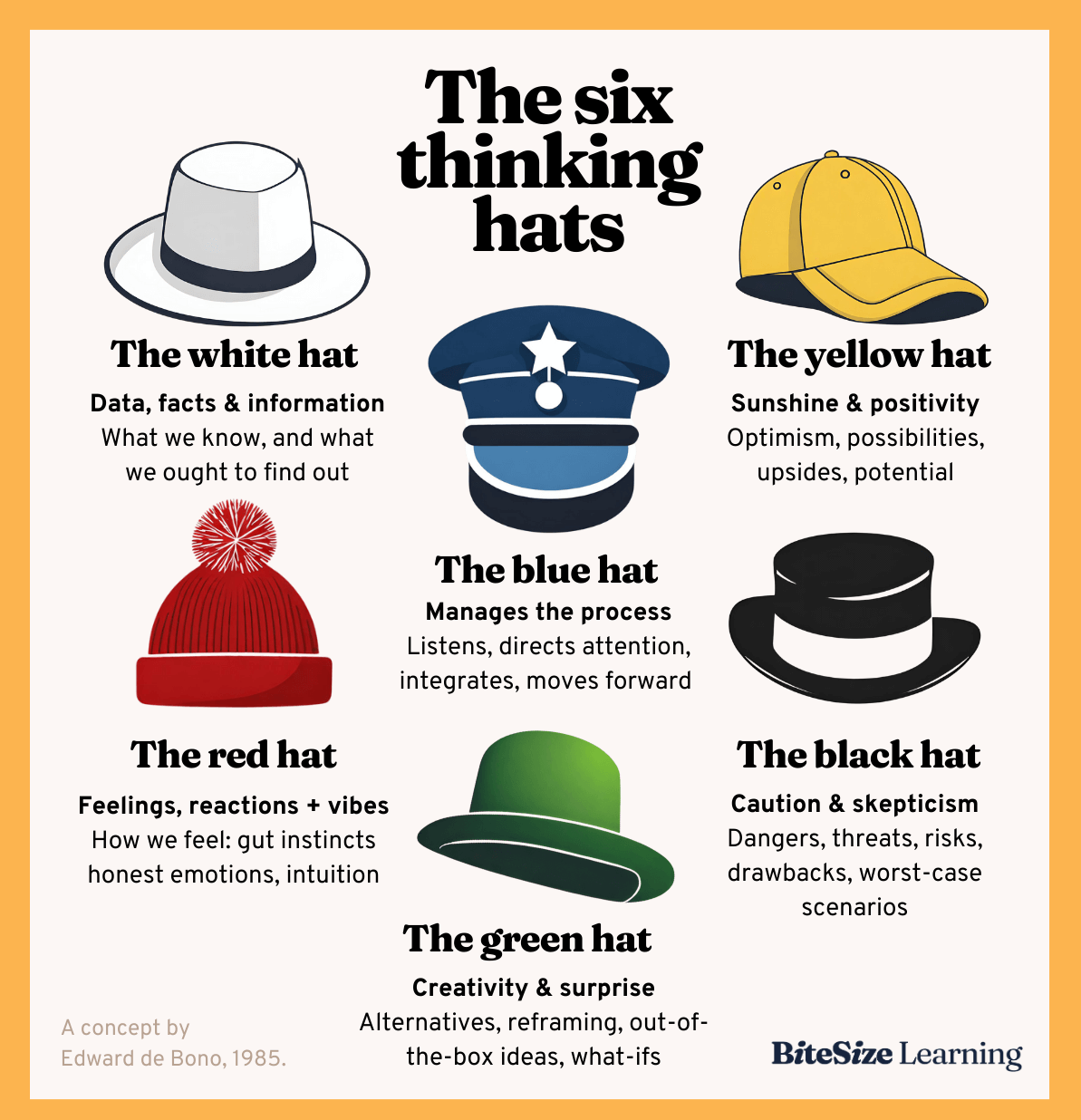Six Thinking Hats
What is it?
Six Thinking Hats is a decision-making method by Edward de Bono where each "hat" represents a different thinking style: facts, emotions, caution, optimism, creativity, and organization
Six Thinking Hats is a simple way to help people think better, solve problems, and make decisions by looking at things from different angles. Imagine wearing a different colored hat, and each hat helps you think in a specific way:
White Hat (Facts Hat) 🧢⚪️:
- Focus: Just the facts, numbers, and data.
- Example: "How many customers complained about the product last month?"
Red Hat (Feelings Hat) 🧢🔴:
- Focus: Your gut feelings and emotions.
- Example: "I feel excited about this idea, but also a bit nervous."
Black Hat (Caution Hat) 🧢⚫️:
- Focus: Spotting risks and problems.
- Example: "What if the product launch fails? Are we prepared for that?"
Yellow Hat (Optimism Hat) 🧢🟡:
- Focus: The positives and opportunities.
- Example: "This idea could boost our sales significantly."
Green Hat (Creative Hat) 🧢🟢:
- Focus: Thinking outside the box, generating new ideas.
- Example: "What if we offer a subscription model instead?"
Blue Hat (Control Hat) 🧢🔵:
- Focus: Organizing the discussion, keeping everyone on track.
- Example: "Let's start with the facts (White Hat) and then move to emotions (Red Hat)."
By “wearing” each hat, a group can think more clearly, avoid arguments, and come up with better solutions together.
Six Thinking Hats: An Expert Explanation
Edward de Bono's Six Thinking Hats is a structured thinking methodology designed to improve collaboration, decision-making, and problem-solving by separating different modes of thought. It aligns with principles from cognitive psychology, systems thinking, and group dynamics, offering a systematic way to overcome biases and cognitive limitations.
1. White Hat (Objective Thinking)
- Principle: Anchored in empiricism and evidence-based reasoning, akin to the scientific method where data is collected and analyzed without interpretation.
- Relation: Similar to Daniel Kahneman's System 2 Thinking (Thinking, Fast and Slow), where slow, logical, and data-driven processing occurs.
- Example: Analyzing quarterly sales figures before strategizing improvements.
2. Red Hat (Emotional Thinking)
- Principle: Draws from affective neuroscience and emotional intelligence (Goleman, 1995), emphasizing that emotions and gut instincts play a crucial role in decision-making.
- Relation: Aligns with Antonio Damasio’s "Somatic Marker Hypothesis" (Descartes' Error), which explains how emotions guide rational decision-making.
- Example: A team member expresses unease about a marketing campaign, prompting a deeper investigation.
3. Black Hat (Critical Thinking)
- Principle: Rooted in risk management and critical analysis, this mode mirrors Karl Popper's principle of falsifiability — actively looking for weaknesses in an idea.
- Relation: Tied to Pessimism Bias (Sharot, 2011), where cautious thinking helps avoid overconfidence in uncertain situations.
- Example: Evaluating what could go wrong in a product launch to prevent failure.
4. Yellow Hat (Optimistic Thinking)
- Principle: Based on positive psychology (Seligman, 1998), focusing on strengths, opportunities, and growth.
- Relation: Aligns with Maslow's Hierarchy of Needs, particularly self-actualization, where optimism fuels innovation and progress.
- Example: Recognizing potential profit increases from a strategic partnership.
5. Green Hat (Creative Thinking)
- Principle: Rooted in divergent thinking (Guilford, 1967) and creativity theory, emphasizing generating new, unconventional ideas.
- Relation: Tied to lateral thinking (also by de Bono), encouraging non-linear solutions to complex problems.
- Example: Brainstorming alternative revenue streams for a declining product.
6. Blue Hat (Metacognition and Control Thinking)
- Principle: Reflects metacognition (Flavell, 1979) — thinking about thinking — and aligns with systems thinking (Senge, 1990), overseeing processes and ensuring alignment.
- Relation: Similar to Agile methodology's retrospective meetings, where processes are reviewed and refined systematically.
- Example: A facilitator ensures the team cycles through all the hats effectively during a strategy session.
Interdisciplinary Connections:
- Cognitive Psychology: Mirrors Daniel Kahneman's dual-system theory.
- Emotional Intelligence: Recognizes the role of emotion in group decision-making (Goleman).
- Critical Analysis: Parallels Karl Popper’s falsifiability principle.
- Positive Psychology: Draws from Seligman’s focus on strengths and optimism.
- Creative Problem-Solving: Aligns with Guilford's divergent thinking model.
- Metacognition: Reflects Flavell’s research on self-awareness in thought processes.
- Systems Thinking: Matches Peter Senge’s holistic approach to organizational learning.
This method transcends simple brainstorming by offering a systematic, scientifically-informed approach to collaborative thinking, reducing conflict, and maximizing creativity.
References
- De Bono, E. (1985). Six Thinking Hats. Little, Brown & Company.
- Kahneman, D. (2011). Thinking, Fast and Slow. Farrar, Straus, and Giroux.
- Damasio, A. (1994). Descartes' Error. Putnam.
- Goleman, D. (1995). Emotional Intelligence. Bantam Books.
- Seligman, M. E. P. (1998). Learned Optimism. Pocket Books.
- Senge, P. M. (1990). The Fifth Discipline. Doubleday.
- Flavell, J. H. (1979). Metacognition and Cognitive Monitoring. American Psychologist.
